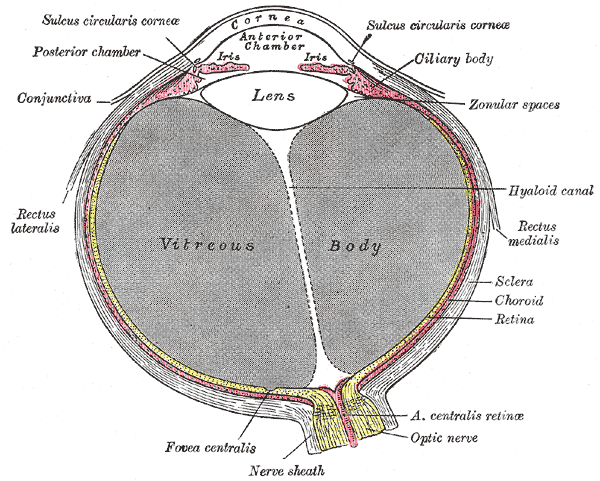UVEA (YOO-vee-uh)
The
pigmented middle of the three concentric layers that make up an
eye
Common clues: Eye
part; Eye layer; Iris's place; Optic layer; Pigmented peeper part;
Ophthalmologist's concern; The eyes have it; Part of the eye;
Colored part of the eye
Crossword
puzzle frequency:
4 times a year
Video: My
Laser Eye Surgery
“To suppose that the eye with all its inimitable contrivances for adjusting the focus to different distances, for admitting different amounts of light, and for the correction of spherical and chromatic aberration, could have been formed by natural selection, seems, I freely confess, absurd in the highest degree.”
Charles Darwin, The Origin of Species
The uvea (Lat. uva, grape), also called the uveal layer, uveal coat, uveal tract, or vascular tunic, is the pigmented middle of the three concentric layers that make up an eye. The name is possibly a reference to its reddish-blue or almost black colour, wrinkled appearance and grape-like size and shape when stripped intact from a cadaveric eye. Its use as a technical term in anatomy and ophthalmology is relatively modern.

Horizontal section of the eyeball. The constituents of the uvea follow: iris labeled at top, ciliary body labeled at upper right, and choroid labeled at center right.
The prime functions of the uveal tract as a unit are:
1. nutrition and gas exchange. Uveal vessels directly perfuse the ciliary body and iris, to support their metabolic needs, and indirectly supply diffusible nutrients to the outer retina, cornea & lens, which lack any intrinsic blood supply.
2. light absorption. The uvea improves the contrast of the retinal image by reducing reflected light within the eye (analogous to the black paint inside a camera), and also absorbs outside light transmitted through the sclera, which is not fully opaque.
In addition some uveal regions have special functions of great importance, including secretion of the aqueous humour by the ciliary processes, control of accommodation (focus) by the ciliary body, and optimisation of retinal illumination by the iris's control over the pupil. Many of these functions are under the control of the autonomic nervous system.
This article is licensed under the GNU Free Documentation License. It uses material from the Wikipedia article "Uvea".
|
|